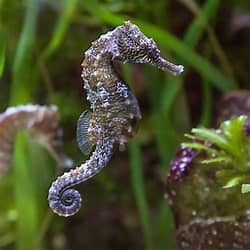Fast Facts: Lined Seahorse
'Hippocampus' is derived from 'hippo' meaning 'horse' and 'kampus' meaning sea monster. Well then. I dread to ponder how the Greeks considered creatures like the Kraken and Scylla.
The Lined Seahorse : Hippocampus erectus
Description: Also known as the Northern Seahorse or Spotted Seahorse, the Lined Seahorse comes in a variety of colors including yellow, orange, red, black, gray, brown, and green. Because they cover such a spectrum of colors, the Lined Seahorse may be difficult to identify sometimes. A defining trait is the white lines that outline the area around the Lined Seahorse's neck and the white dots spotting the seahorse's tail. These seahorses are also characterized by its armor-like body which contains 50 plates that cover its body in place of scales.
Habitat: Primarily found in the area outlined by North and South America's Atlantic coast and the eastern Mexican Gulf, the Lined Seahorse is the only seahorse found in the Chesapeake Bay. It also only inhabits shallow waters ranging from 2 to 230 feet in depth. To prevent being washed away from strong tides and waves, it clings to aquatic vegetation using its prehensile tail. Some of these vegetation types include mangroves, seagrasses, and corals.
Diet: Using its uniquely shaped nose to swallow prey whole, the Lined Seahorse doesn't have a mouth or teeth, which seems to surprise many people because these creatures are carnivorous. Lined Seahorses can only feed on prey small enough to fit their noses and digestive tracts including shrimp, worms, fish larvae, and other tiny crustaceans and zooplankton.
Behavior: Like all other seahorse species, the Lined Seahorse male of a breeding pair is the one to incubate eggs in his pouch. This incubation takes place for around 20 days until the juvenile seahorses are ejected into the water. Once this ejection occurs, the young seahorses are completely independent. Because survival rates are so low to the point where only around one out of every 1000 seahorses survive, the female Lined Seahorse will deposit up to 2000 eggs into the male's pouch. Additionally, like many seahorse species, Lined Seahorses are monogamous, staying with one mate for the majority of their lives. Seahorses are also known for their dedicated courtship rituals, often performing daily dances to reinforce their relationship.
Conservation Status: The Lined Seahorse is categorized as Threatened. Although its exact population is unknown, research suggests that the population is declining due to illegal trade efforts and commercial fishing which includes both targeted fishing and bycatch.
Unique Traits: As stated above, Lined Seahorses come in an array of colors. These varying shades, along with their trademark white-lined bodies, allow the Lined Seahorse to camouflage with its surroundings. Furthermore, the Lined Seahorse may also change color to blend into its specific habitat because of special organs called chromatophores. These contain several color pigments and are activated by the seahorse's nervous system.
Camouflaging is necessary to survive as a seahorse as these creatures are not suited for swimming. Lined Seahorses' fragile bodies move around in an upright position, utilizing its flippers to move horizontally and its bladder to move vertically. This bladder is inflatable which allows a seahorse to regulate its level of depth. The Lined Seahorse's vertical position also means they can easily be swept away from shallow waters if untethered to vegetation, which also acts as shelter from predators.
https://www.floridamuseum.ufl.edu/discover-fish/species-profiles/hippocampus-erectus/
https://aqua.org/explore/animals/lined-seahorse
https://oceaninfo.com/animals/lined-seahorse/
https://oceaninfo.com/animals/lined-seahorse/#:~:text=The%20lined%20seahorse%2C%20just%20like%20other%20seahorse%20species%2C,stomach%2C%20so%20they%20need%20to%20feed%20almost%20constantly.
https://www.seafishpool.com/lined-seahorse/




Comments
Post a Comment